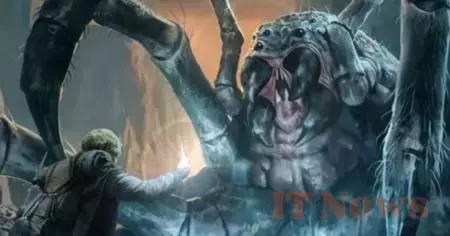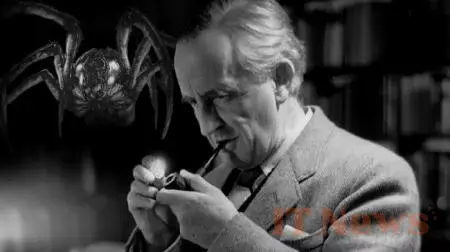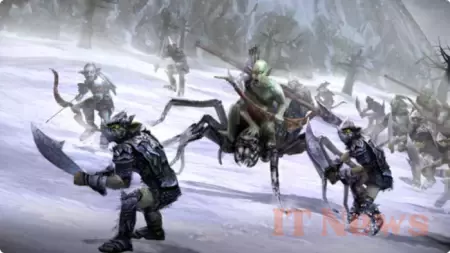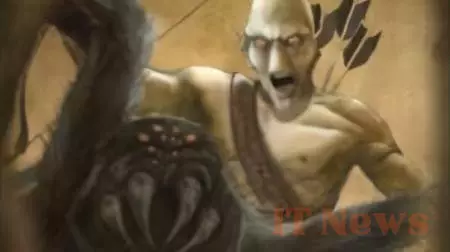In the Lord of the Rings trilogy, Shelob is a gigantic spider who attempts to devour Frodo, the ring-bearer. But beyond her monstrous appearance, Shelob is a complex being, with a history as dark as it is mysterious. From her place in Tolkien's writings to her role in Peter Jackson's films and the Expanded Universe, here are 8 facts you (maybe) don't know about Shelob.
#8 Tolkien invented Shelob and the giant spiders for his son (making of)
For a long time, a rumor circulated that J.R.R. Tolkien invented the giant spiders in The Hobbit, and then Shelob in The Lord of the Rings, after a tarantula bite as a child. In reality, this idea is false. Tolkien first introduced these creatures when writing The Hobbit for his children, and more specifically for his son Christopher, who suffered from arachnophobia. He wanted to give him a hero, Bilbo Baggins, who could face and conquer his fears—in this case, spiders. It is therefore Christopher Tolkien's arachnophobia that influenced the presence of spiders in the universe of Middle-earth.
#7 Shelob is surely not the last giant spider in Middle-earth (canon)
Shelob is presented as an entity as exceptional as it is frightening during her confrontation with Frodo and Sam in the darkness of Cirith Ungol. However, things are not so simple: Shelob is in reality much more than a mere remnant of an ancient evil. A descendant of Ungoliant, a monstrous entity once allied with Melkor, Shelob is one of the countless giant spiders that have infested Middle-earth since the First Age. These intelligent and malicious creatures lived in the darkest corners, such as Ered Gorgoroth or, later, Mirkwood, renamed after the arrival of many spiders who came with Sauron's shadow. Bilbo Baggins faced some of them in The Hobbit, proving that Shelob was not the only one of her kind to survive. Their language, cunning, and aversion to light are testaments to their ancient power. So, like most peoples of lore, the spiders spread across Middle-earth. It is therefore more than likely that other "cousins" of Shelob still lurk in the darkness after the fall of Sauron, ready to weave their deadly webs. Moreover, Shelob herself fled after her defeat, and while her fate remains unknown, it is possible that she has found a new refuge.
#6 It may have been Morgoth who created Shelob's mother (Fan theory)
The origins of Ungoliant, the first giant spider of Middle-earth and ancestor of Shelob, remain shrouded in mystery. Even the Valar (the gods or archangels, depending on your reading of the lore) don't know where she really came from. Some Elves believe she was once a Maia (the beings from which Gandalf and other wizards descend) corrupted by Morgoth, while others believe she came from beyond this planet, born from the outer Void of infinite space. However, one theory proposes that Morgoth accidentally caused her birth. Indeed, the universe Tolkien describes originated from an event called the Music of the Ainur, where the gods sang together about the creation of the world in harmony (to put it simply). It was at this moment that Morgoth, the future Dark Lord, introduced a dissonance into this cosmic melody.
If this disharmony did not destroy the world, it could have spawned monstrous entities, such as the "Nameless Things." Ungoliant could thus be the product of this original dissonance. This connection would explain why she allied with Morgoth to destroy the Two Sacred Trees of Valinor, and why the spidery darkness later reappeared with Shelob under Sauron. Although Ungoliant turned against Morgoth before disappearing into the south of the world, her influence persists. This theory reinforces the idea of an ancient evil, born of Chaos itself, surviving through its dark-weaving descendants—a web whose origins can be traced back to the very first cracks in the creation of Middle-earth.
#5 Here's why the Phial of Galadriel is so feared by Shelob (canon)
In The Lord of the Rings, the Phial of Galadriel allows Frodo and Sam to escape Shelob, the giant spider lurking in the darkness of Cirith Ungol. This flask, a gift from the Lady of Lothlórien, contains the light of Eärendil's star, itself descended from the legendary Two Trees that preceded the sun and the moon. Shelob, degenerate descendant of Ungoliant—a monstrous creature that once devoured the light of these trees—cannot bear this sacred brightness. Where Ungoliant consumed the light, Shelob, secluded in darkness, is unaccustomed to it. Her dark heritage has weakened her power against this pure light, reserved for noble souls and destructive to evil. Unlike her mother, Shelob hunts flesh, not light. Faced with Galadriel's flask (which is her nemesis as we explained here), she retreats, overcome not by physical power, but by the luminous echo of an ancient world, the vivid memory of which she cannot bear.
#4 Tolkien created a song in homage to Shelob's cousins (canon)
From The Hobbit, J.R.R. Tolkien introduced the giant spiders of Mirkwood into his universe. However, the childish tone of the book slightly downplays the situation and these monsters, adding a touch of humor and poetry. So, to distract these monstrous cousins of Shelob and save the Dwarves trapped in their web, Bilbo Baggins improvises a mocking song: "Big old spider spinning her web in a tree!" This satirical rhyme mocks their names—Lazy Lob, Crazy Cob, Old Tomnabot—and highlights their clumsiness. Through his verses, Tolkien briefly humanizes these frightening creatures while enriching the mythology with an ancient, creeping evil, descended from the descendants of Ungoliant. Another interesting detail: the names Bilbo gives to the spiders already prefigure that of Shelob, and all seem to be inspired by old English words related to spiders. Thus, lob is an old word for "spider," and cob can also refer to a spider or a web.
#3 The spider that inspired Shelob in the films really exists (making of)
If Shelob, the monstrous spider in The Return of the King, terrified millions of viewers, it's perhaps also because it was inspired by a real creature. Indeed, during the creation of the film, Peter Jackson, a notorious arachnophobe, asked his teams to design the most terrifying spider possible (as we explained here). To achieve this, special effects supervisor Jim Rygiel suggested taking inspiration from a local New Zealand species: the Black tunnelweb (Porrhothele antipodiana). This spider, although small (about 3 cm), lives in underground tunnels (like Shelob, therefore) and can inflict a painful bite. As a child, Jackson often encountered them in his garden, which had a profound impact on his imagination. Thus, Shelob is not just a fictional monster, she is also the nightmarish amplification of a real arachnid. This link between personal phobia and monstrous exaggeration of reality gives the Shelob of the film an even more chilling dimension on screen.
#2 The goblins have joined forces with Shelob's cousins (extended universe)
In the video game The Lord of the Rings: The Battle for Middle-earth II, the Goblin Spider-riders appear. These characters seem clearly inspired by the Forest Goblins Spider Riders, first introduced to the Warhammer universe in 1996. In the game, these goblins ride giant spiders—though smaller than Shelob—to fight as a light cavalry unit. Equipped with spears and bows, they can switch roles as needed and deal poison damage. The spiders themselves can be enhanced with Venom Sacks, and their ability to trample infantry adds to their danger.
From the perspective of "Tolkienian" mythology, however, this alliance seems implausible. Tolkien's great spiders, descendants of Ungoliant, are intelligent, independent, and malevolent. They were never domesticated and showed no cooperation with goblins. Instead, Shelob feeds on orcs, and the spiders of Mirkwood capture living beings to devour them. In fact, while Spider-riders are coherent and particularly fun as a gameplay concept, their existence in a universe faithful to Tolkien is highly unlikely.
#1 Shelob has children (expanded universe)
While Shelob is already terrifying on her own, the expanded universe of The Lord of the Rings imagines an equally nightmarish offspring for her. In the video game The Lord of the Rings: Gollum (2023), several small spiders, called "spiderlings," are presented as the children of Shelob. These pale, hairy creatures live in the depths of Barad-dûr, where Gollum must use cunning to escape them. Although not directly derived from Tolkien's writings, they were neverthelessintroduced with the approval of the prestigious Tolkien Estate.
But this isn't the only time Shelob's offspring appear. In the video game The Lord of the Rings: War in the North, players faceSaenathra, a gigantic spider presented as Shelob's daughter. Saenathra appears to be the most powerful of her daughters. Queen of the spiders of Mirkwood and ally of Sauron, she lives near Dol Guldur and commands an army of monstrous spiders. Even larger than her mother, she attempts to devour the magician Radagast the Brown, before being defeated by the game's heroes Andriel, Eradan, and Farin.
And if you want to know more about the world of Shelob, you can also discover our files on The Goblin King parts 1 and 2, Morgoth, Sauron parts 1 and 2, or Shelob, part 1.








0 Comments